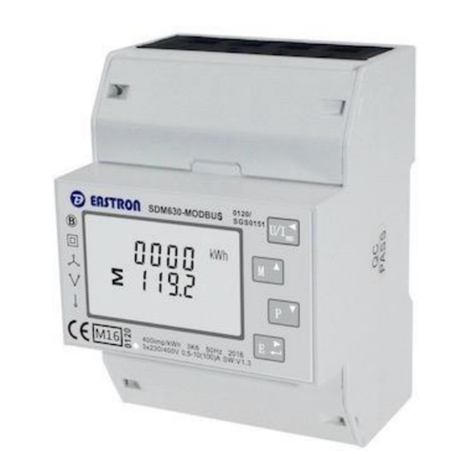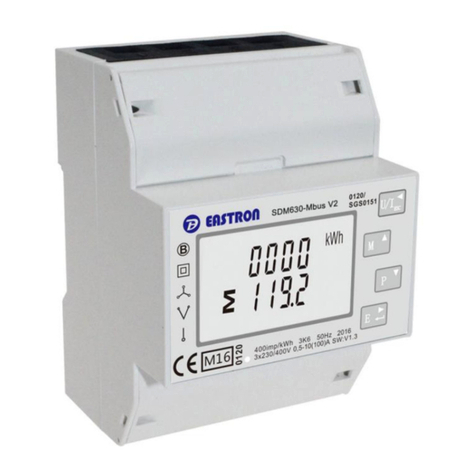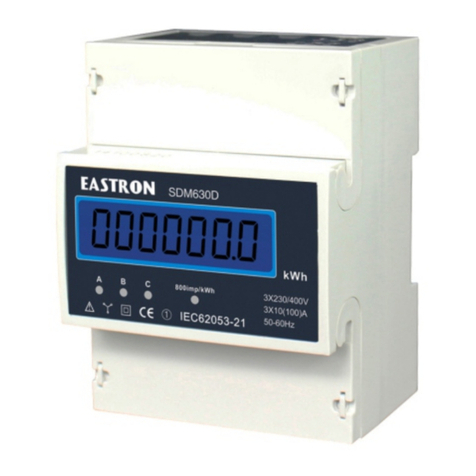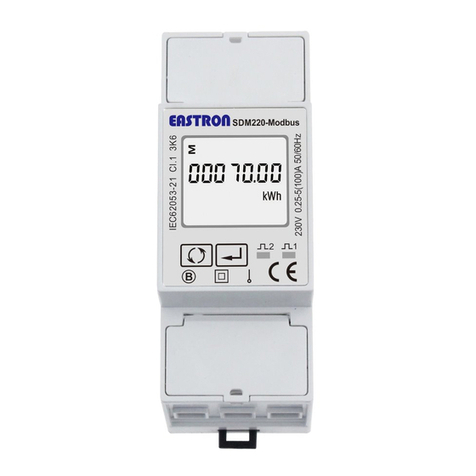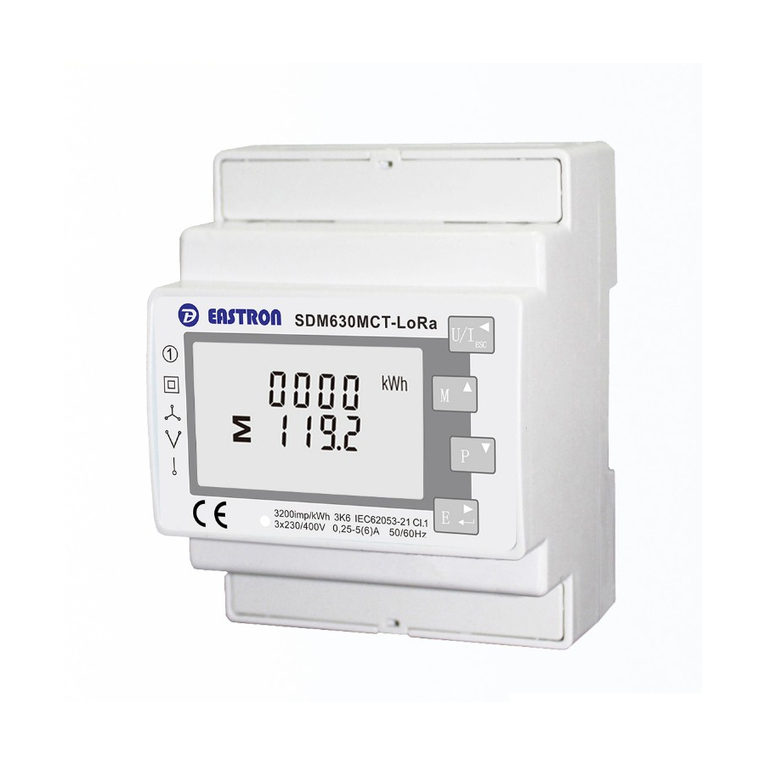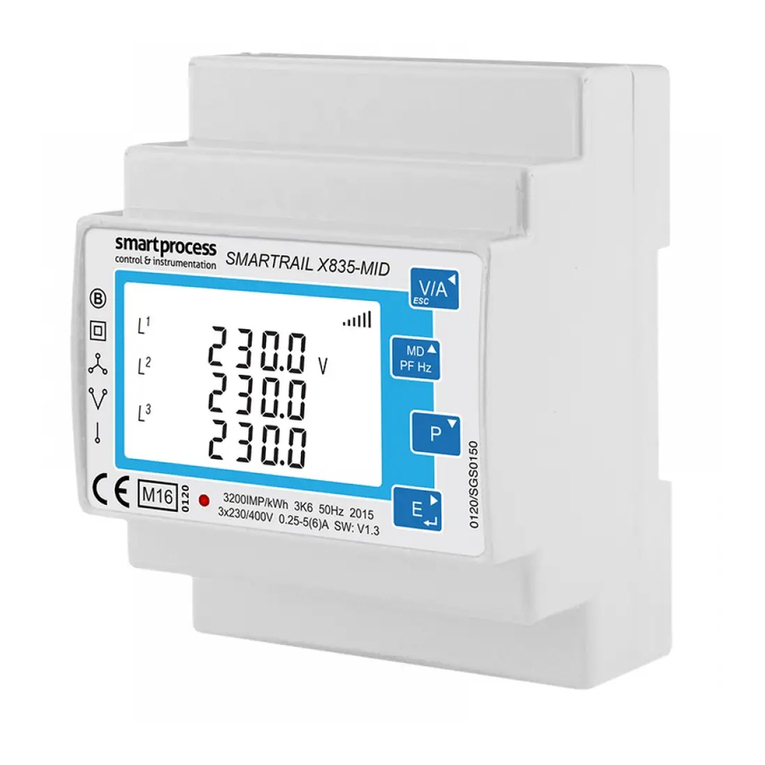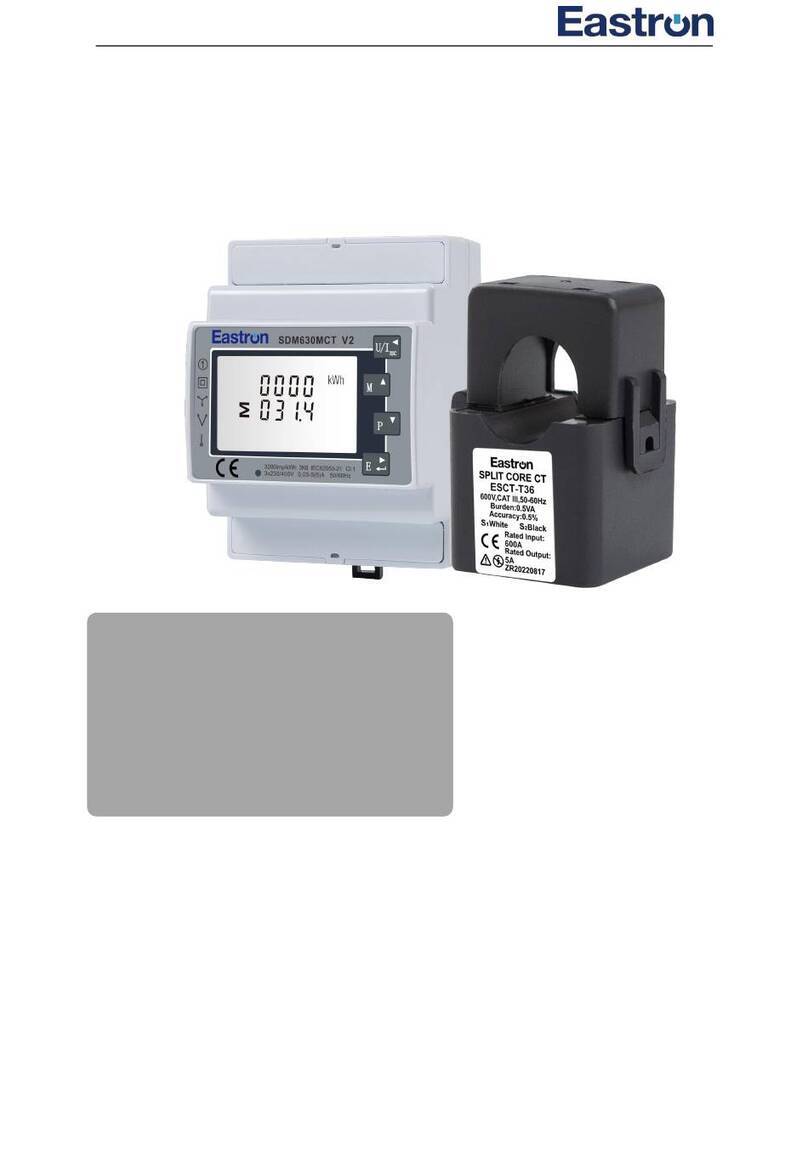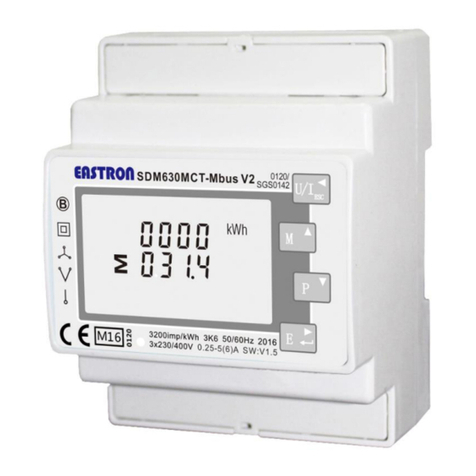
User Manual
2020
SDM630MCT-2L
DIN Rail Smart Energy Meter for Single and Three
Phase Electrical Systems
1Introduction
This document provides operating, maintenance and installation
instructions. This unit measures and displays the characteristics of
Single Phase Two Wire (1P2W) and 2 x (C1 & C2) Three Phase Four
Wire (3P4W) networks. The measuring parameters include Voltage
(V), Current (A), Frequency (Hz), Power (kW/KVA/KVAr), Power
Factor (PF), Imported, Exported and Total Energy (kWh/kVArh). The
unit also measures Maximum Demand Current and Power, this is
measured over preset periods of up to 60 minutes.
This particular model accommodates 100mA Current Transformers
and can be congured to work with a wide range of CTs. It also
comes with a complete comms capability with built in RS485
Modbus RTU outputs, conguration is password protected.
This unit can be powered from a separate auxiliary supply (AC or
DC). Alternatively, it can be powered from the monitored supply by
linking the voltage reference and neutral reference in to terminals 5
& 6 (Please refer to wiring diagram).
1.1 Unit Characteristics
The SDM630MCT-2Lcan measure and display 2 x Three Phase
circuits (C1 & C2) :
• Phase to Neutral Voltage and THD% (Total Harmonic Distortion)
of all Phases
• Line Frequency
• Current, Maximum Demand Current and Current THD% of all
Phases
• Power, Maximum Power Demand and Power Factor
• Imported, Exported & Total Active Energy
• Imported, Exported & Total Reactive Energy
The unit has a Password-Protected set up menu for:
• Changing the Password
• System Conguration - 1P2W & 3P4W.
• Demand Interval Time
• Reset for Demand Measurements
1.2 Current Transformer Primary Current
This unit requires conguring to operate with the appropriate
curren transformer(s), thesecondary current is 0.1A. It is
programmed by inputting the ratio (CT Primary). It can be used on
primary currents up to 6000A.
1.3 RS485 Serial – Modbus RTU
This unit is compatible with remote monitoring through RS485
Modbus RTU. Set-up screens are provided for conguring the
RS485 port. Refers to section 4.8.
2Start Up Screens
The rst screen lights
up all display segments
and can be used as a
display check.
The second screen
indicates the rmware
installed in the unit and
its build number.
The interface performs a
self-test and indicates the
result if the test passes.
*After a short delay, the screen will display active
energy measurements.
3Measurements
The buttons operate as follows:
ESC
U/I
Selects the Voltage and Current display
screens. In Set-up Mode, this is the
“Left” (press) or“Escape”(hold 3sec)
button.
Select the Frequency and Power factor
display screens. In Set-up Mode, this is
the“Up”(press) button.
Select the Power display screens.
In Set-up Mode, this is the
“Down”(press) button.
Select the Energy display screens.
In Set-up mode, this is the
“Right” (press) or“Enter”(hold 3sec)
button.
3.1 Switching Three Phase Circuit Display
Default is Circuit 1 (C1).
To Switch from Circuit 1 (C1)
to Circuit 2 (C2) press and
hold the button. Press
and hold again to switch
back to C1.
3.1.1 Voltage and Current
Each successive press of the
U/I
button selects a new parameter:
Phase to neutral voltages.
Phase to Phase voltages.
Current on each phase.
Phase to neutral voltage
THD%.
Current THD% for each
phase.
3.2 Frequency and Power Factor and Demand
Each successive press of the button selects a new range:
Frequency and Power
Factor (total).
Power Factor of each
phase.
Maximum Power Demand.
Maximum Current
Demand.
3.3 Power
Each successive press of the button select a new range:
Instantaneous Active
Power in kW.
Instantaneous Reactive
Power in kVAr.
Instantaneous Volt-Amps
in KVA.
Total kW, kVArh, kVA.
3.4 Energy Measurements
Each successive press of the button selects a new range:
Imported active energy
in kWh.
Exported active energy
in kWh.
Imported reactive energy
in kVArh.
Exported reactive energy
in kVArh.
Total active energy in kWh.
Total reactive energy in
kVArh.
Please note the register is 9999999.9 display over two lines.
4Set Up
4.1 Set up Entry Methods
Some menu items, such as Password and CT, require a four-
digit number entry while others, such as supply system, require
selection from a number of menu options.
4.1.1 Menu Option Selection
1. Use the and buttons to scroll through the dierent
options of the set up menu.
2. Hold the button for 3 seconds to conrm your selection.
3. If an item ashes, then it can be adjusted by the and
buttons.
4. Having selected an option from the current layer, hold the
button for 3 seconds to conrm your selection.
5. Having completed a parameter setting, hold the
U/I
button for
3 seconds to return to a higher menu level.
6. On completion of all setting-up, hold the
button for 3
seconds, the measurement screen will then be restored.
4.1.2 Number Entry Procedure
When setting up the unit, some screens require the entering
of a number. In particular, on entry to the setting up section, a
password must be entered. Digits are set individually, from left to
right. The procedure is as follows:
1. The current digit to be set ashes and then can be adjusted using
the and buttons.
2. Press the button to more right to the next digit.
3. After setting the last digit, hold the button for 3 seconds to
save your selection.
4.2 Communication
The RS485 port can be used for communication using Modbus RTU
Protocol. To congure the Modbus settings, such as Address and
Baud Rate, this is also done within the Password-protected set up
menu.
4.2.1RS485 Address
Use the and
buttons to select the menu
option. The screen will show
the current setting.
Hold the button to set
the meter Address.
Range: 001(default) to 247.
Hold the button to
conrm the selection.
Use the and buttons to choose the necessary number,
then press the button to move along to the next number. To
save the new setting, hold the button for 3 seconds until the
selection stops ashing.
4.2.2 Baud Rate
Use the and
buttons to select the menu
option. The screen will show
the current setting.
Hold the button to
enter the menu option, the
current selection will ash.
Use the and
buttons to select the
required option.
On completion of the entry procedure, hold the button to
conrm the setting.
4.2.3 Parity
Use the and
buttons to select the menu
option. The screen will show
the current setting.
Hold the button to
enter the menu option, the
current selection will ash.
Use the and
buttons to select the
required option.
Range: None (default), Odd
or Even.
On completion of the entry procedure, hold the button for 3
seconds until the selection stops ashing.
4.2.4 Stop bits
Use the and
buttons to select the menu
option. The screen will show
the current setting.
Hold the button to
enter the menu option, the
current selection will ash.
Use the and
buttons to select the
required option.
Range: 1 (default) or 2.
On completion of the entry procedure, hold the button for 3
seconds until the selection stops ashing.
4.5 CT Conguration
This unit is CT Operated, the primary (CT1) and secondary (CT2) of
the current transformer need to be programmed correctly for the
meter to scale the inputs accordingly.
%
%
Use the and
buttons to select the menu
option. The screen will show
the congure CT setting.
%
%
C1
Set the CT Ratio Value:
Hold the button to
enter the CT Ratio setting
screen. The range is from
0001 to 9999. 0005A default
%
%
C2
o Switch from Circuit 1 (C1)
to Circuit 2 (C2) press and
hold the button. Press
and hold again to switch
back to C1.
%
%
Secondary CT (CT2):
Hold the button to set
the CT secondary option:
0.1A.(Not Congurable)
The CT Rate is the primary rate/ratio of the CT.
For Example: 200/100mA Current Transformers , so the CT Rate
would be 0200 and the CT2 would be 0.1A.
4.6 PT
The PT option sets the Secondary Voltage (PT2 100-500V) of the
VoltageTransformer (PT) that may be connected to the meter.
Use the and
buttons to select the menu
option. The screen will show
the current setting.The
default value is 400V.
Secondary PT Setting:
Hold the button to set
the PT secondary option:
100-500V.
Set the PT Ratio Value:
Hold the button to
enter the PT Ratio setting
screen. The range is from
0001 to 9999.
The PT Rate is the PT Primary divided by the PT Secondary. For
Example: Voltage Transformer - 11000÷110=100, so the PT Rate
would be 0100 and the PT2 would be 110.


